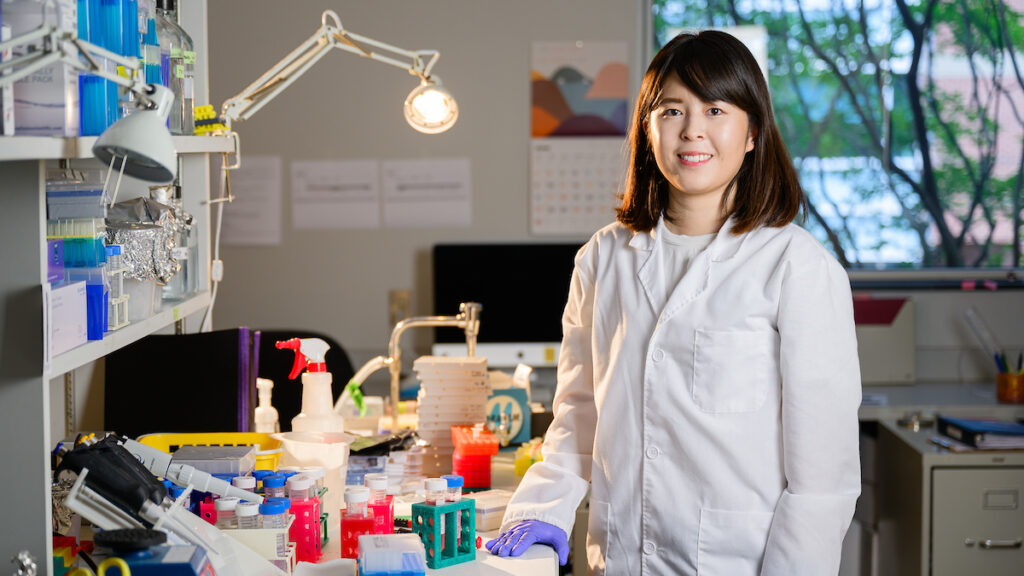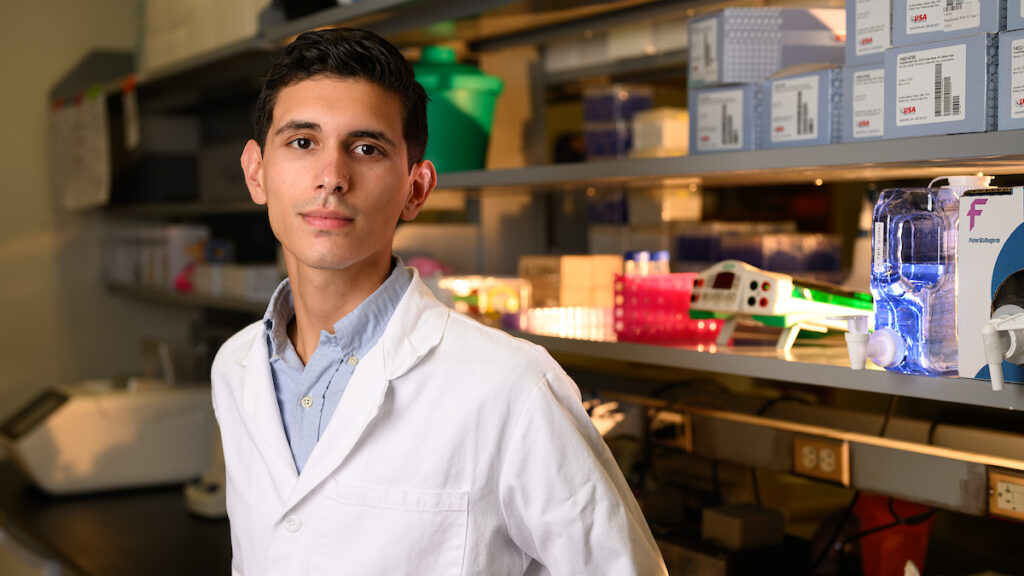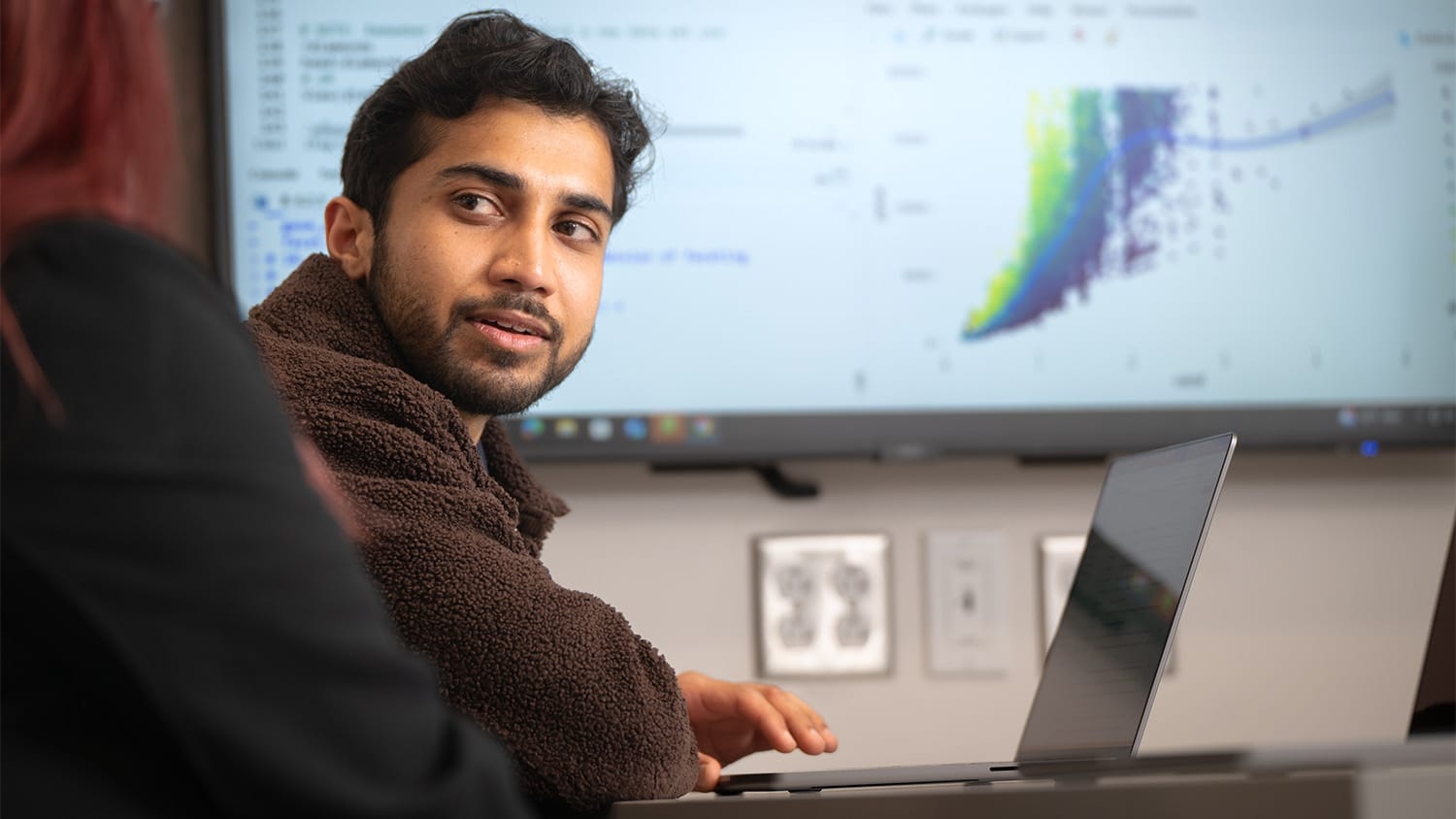For Victor Rivas, Aoi Nakanishi-Hester and other research-minded students, the NC State College of Veterinary Medicine’s DVM/Ph.D. program, which provides the opportunity to combine a doctor of veterinary medicine degree with a Ph.D., is an undeniable example of the college’s world-class caliber.
NC State’s veterinary college is one of only five or six in the country that offer a structured dual-degree program that also provides substantial financial support for the students, says Dr. Sam Jones, director of both the combined DVM/Ph.D. program and the Comparative Biomedical Sciences Program at NC State.
“The college sees this investment as important for not only supporting our dual-degree program, but also supporting the profession and trying to bolster the number of people who are doing research as a veterinarian,” says Jones, noting that the two degrees can take seven or eight years to complete. “The program also supports the pathway for veterinarians who want to become faculty members, which is needed now more than ever.”
A recent study, with NC State College of Veterinary Medicine Dean Kate Meurs as an author, found that the expansion of class sizes at U.S. veterinary schools and the addition of new veterinary schools and colleges have increased the urgency to address an impending shortage of veterinary medical educators.
Jones arrived at NC State in 1998 as an equine faculty member and researcher focused on immunology and the role neutrophils play in inflammation. As he worked on his research with several graduate students, he realized the College of Veterinary Medicine needed to formalize the way it offered its dual DVM/Ph.D. program so that more veterinary students could afford to enroll and succeed. He became the program’s first director in 2007.
Usually, the dual-degree program is structured so that students finish one year of Ph.D. work and then two years of veterinary college coursework, two to three years of Ph.D. work then the final two years of the four-year veterinary school curriculum.
“It intertwines Ph.D. and DVM training to make the most of the early years of vet school in order to connect students to the research interest of the Ph.D. student,” says Dr. Joshua Stern, associate dean for research and graduate studies at the NC State College of Veterinary Medicine. “The idea is that they will use that knowledge that they’re getting in their early years as a springboard to ask better research questions and to focus their hypotheses and refine their interests in research.”
NC State often works with students who need different pathways, Jones says, and that has included both Rivas and Nakanishi-Hester.
‘I’m really fortunate to be at NC State’

Rivas started his Ph.D. at the University of California at Davis, where he worked with Stern, previously at UC-Davis, researching genetic causes of cardiomyopathy in cats. He also worked in Stern’s lab when he received a master’s in genetics at UC-Davis, having started his undergraduate work there at age 16.
When Stern moved to NC State last year, Rivas wanted to continue studying the genetics of heart disease and enrolled in the dual-degree program at NC State. He finished his Ph.D. work in June and will begin four consecutive years of veterinary school in the fall.
“I’m really fortunate to be at NC State,” says Rivas, a native of Nicaragua. “I like the interdisciplinary aspect of the program, both the Ph.D. and the vet school. I like the flexibility that the programs give to the students and the fact that you can enter individual tracks. I also like the independence that the students have and was fascinated by the outstanding clinical facilities as well. You can definitely tell that NC State cares about the facilities and equipment it offers for the clinical aspect of vet school.”
Nakanishi-Hester is a native and citizen of Japan, though her family settled in Chapel Hill before she entered high school. She finished the second year of her Ph.D. training in May and will start her first two years of veterinary school in the fall. She always knew she wanted to be a veterinarian, and she started shadowing Dr. Duncan Lascelles, the director of the Translational Research in Pain program at the NC State College of Veterinary Medicine, while in high school.
When preparing for college, she could have chosen to return to Japan, but she was hooked on the research into pain and inflammation that she had started with Lascelles and continued to work in his lab as she received an undergraduate degree in animal science from NC State.
“I realized I really, really liked research,” she says. “So then I had to decide between doing either a Ph.D. or DVM, and I just couldn’t decide which I wanted to do.”


She applied to and was accepted into both the Ph.D. and DVM programs at the NC State College of Veterinary Medicine and still had a quandary. She didn’t think she qualified for the dual-degree program because of her citizenship status, but Jones found a path.
“We’re delighted to have students like Aoi as part of our community, so that’s No. 1,” Jones says. “And then there has been a chronic shortage of veterinary researchers. This is a way to encourage students to embrace a career that includes research as veterinarians. We want them to become clinician scientists. That doesn’t mean they’re necessarily working as clinical veterinarians, but they are veterinarians doing research.”
Between 30 and 35 students typically apply each year to the DVM/Ph.D. program, and only two are admitted, Jones says, leading to about 15 dual-degree students at NC State at any given time. Spread among the country’s other 30-plus veterinary colleges are about 130 other dual students, he says.
“Our college is really aiming at creating folks to go out and practice veterinary medicine with Day One skills in a number of different areas,” Jones says. “We have veterinarians who go out and do tons of different things, but adding the Ph.D. onto that gives them an entirely different trajectory or focus.”
As for Rivas, he hopes his research trajectory leads to discovering novel compounds for treating the primary symptoms of genetic heart diseases and for preventing the diseases in the first place — in both animals and humans.
“My ultimate goal is to become a tenure-track faculty member doing clinical research as well as benchtop research and to continue doing what essentially Dr. Stern does now,” Rivas says. “We’re integrating both the clinical and molecular biology aspects of cardiology.”
With her Ph.D. focused on neuroscience, Nakanishi-Hester is collaborating with the lab of Dr. Natasha Olby, a world-renowned expert in veterinary gerontology and the aging process in dogs. Specifically, Nakanishi-Hester is studying the role of inflammation in the progression of Alzheimer’s disease.
“If I were to do just a Ph.D., I would be working mostly with mice, but because I am in the dual-degree program, I’m actually working with Dr. Olby’s lab in their work on canine cognitive dysfunction syndrome, which is basically Alzheimer’s in dogs,” she says. “Dogs are a great model because they live like humans, they eat kind of like humans, they share the environment. So I’m double approaching human and dog diseases, and I think that’s one of the greatest things that this dual-degree program allows us to do.”
A worthy investment


Both Stern and Jones emphasize the life-changing importance of the work that NC State’s dual-degree program graduates contribute to advancing science in a variety of ways.
In May, Dr. Grayson Walker and Dr. Annie Wang, who both already received their Ph.D.s as part of the program, finished up their fourth DVM year and headed to critical federal research positions.
Walker, a North Carolina native, focused on researching infectious diseases with mentors Dr. Luke Borst and Mitsu Suyemoto at NC State and is working as a veterinary medical officer at the National Bio and Agro-Defense Facility, part of the U.S. Department of Agriculture. Wang, whose primary research at NC State was on antimicrobial resistance with mentor Dr. Cristina Lanzas, is putting her skills to use at the Centers for Disease Control and Prevention.
Jones says about 50% of the dual-degree students go into academic-type positions and the others into government or industry research careers. Either way, the investment in helping driven students put their passions to work to improve the lives of animals and humans alike is worth every dollar, he says.
“Leading this program lets me combine my research interests with helping people be successful, and that’s been the most rewarding part,” Jones says. “I can be a lot more innovative programmatically here, I think, than in previous roles, and I also don’t have to wear a tie. Ever.”
For extraordinary students who know they want careers in translational or veterinary research, the dual-degree program just makes sense, Stern says.
“This is a really great way to kind of kill two birds with one stone, right?” he says. “You’re in a place where you’re already learning the faculty, you’re learning the labs, you’re getting comfortable. You’re amassing all of this experience, and you can move right into a Ph.D. program in that process. The two programs really do kind of have a symbiotic relationship that takes a life of its own.”
This post was originally published in Veterinary Medicine News.
- Categories:



